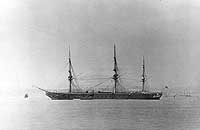
HMS Warrior, a 9137-ton ironclad frigate, was built at Blackwall, England. The first of the Royal Navy's many ironclad capital ships, she entered service in October 1861, somewhat over a year after the completion of the French battleship Gloire opened an international competition in armored warships that was to continue for over eight decades. Warrior was assigned to the Channel Fleet, in which she spent nearly all of her seagoing service guarding Great Britain and the eastern Atlantic against potential maritime threats. The routine of this duty was punctuated by a collision with HMS Royal Oak on 14 August 1868 and special service towing a large floating drydock to Bermuda in mid-1869.
Warrior had her gun battery upgraded during a refit in 1864-67 and received other modifications in 1872-75. After the latter dockyard period, she was in reserve service until 1883, making summer cruises in waters from Gibraltar to the Baltic and receiving occasional temporary assignments with the Channel Fleet. From 1883 until about 1900, the ageing ship, now reclassified as an armored cruiser, was laid up, though available for recall to combatant duties.
Beginning in 1901, Warrior was employed as a storage and depot ship for torpedo vessels at Portsmouth and was attached to the torpedo school, HMS Vernon, from 1904 until 1923. She was renamed Vernon III during most of this time, but regained the name Warrior at the end. After attempts to sell her for scrap produced no purchasers, in 1927-29 the ship was converted to an oil facility mooring hulk at Pembroke. She again lost her name during World War II, but continued her modest employment into the 1970s. By this time, her value as a unique historic relic was widely recognized, and in 1979 she was transferred to the Maritime Trust for preservation as a museum ship. After extensive restoration work, Warrior was placed on exhibit at Portsmouth, England, where she remains today.
This page features all our views of the British ironclad frigate Warrior (1861-1979).
| If you want higher resolution reproductions than the digital images presented here, see: "How to Obtain Photographic Reproductions." |
Click on the small photograph to prompt a larger view of the same image.
| If you want higher resolution reproductions than the digital images presented here, see: "How to Obtain Photographic Reproductions." |
Page made 12 July 2001